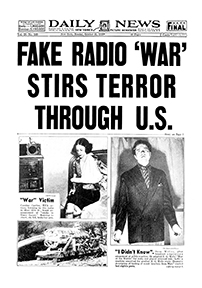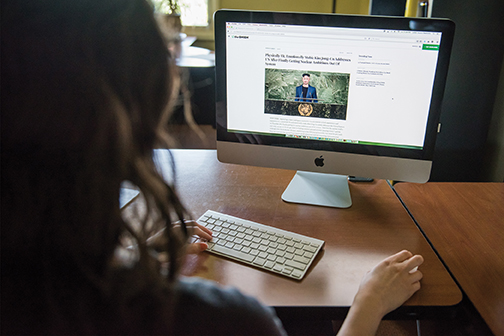 With Jason Loviglio, Founding Chair and Associate Professor, Media and Communication Studies
With Jason Loviglio, Founding Chair and Associate Professor, Media and Communication Studies
The phrase “ fake news” may sound current, but as long as there have been written and visual media, readers and audiences have puzzled and debated over how to interpret what is true. With The War of the Worlds, Orson Welles created one of the best-known early examples of broadcast audiences mistaking fiction for fact, when a small fraction of listeners tuning in to the 1938 radio broadcast reacted with panic, certain that aliens, or Germans, were invading.
Today’s media consumers must filter input from various sources quickly and be cautious of acting without verifying the validity of what they are seeing. Now, more than ever, we are asking questions like: Has the photo been manipulated? Is the headline overblown? Is this article opinion or reporting? Thankfully, we now also have more tools to help us understand what is real, commentary, or entertainment. And, we have Jason Loviglio, who teaches a “Media Literacy” course on this very topic, here with tips to make sense of it all.
— Catalina Sofia Dansberger-Duque
STEP 1. KEEP CALM AND FOLLOW THE MONEY
First things first. You are reading, watching, or listening to news because it is in someone’s economic interest to have you do so. Understanding the corporate interests that own the media outlets and produce the media content you consume will help you understand the limits of their perspective.
So “breaking news” happens 24/7. “Crises” will be uncovered daily. And a general atmosphere of immediacy, urgency, and even panic are now part of the genre of electronic news media. Take a deep breath. Keeping us in crisis mode is great for ratings, click rates, and newsstand purchases, but it’s not that good for us.

STEP 2. CHECK YOUR FACTS
We hear a lot about “fake news” from all quarters. Do your sleuthing. Using the resources listed below, check out news sources to better understand their biases and their journalistic credentials.
A quick way to determine what is dominating mainstream media’s national attention is to check out what stories are trending on Twitter, CNN, Washington Post, and The New York Times. These sources will give you a sense of what is being talked about, but may not provide a great deal of insight into why.
STEP 3. CHECK YOUR PRIORITIES
Humans have used stories, songs, and images to instruct, entertain, influence, and inform for thousands of years. Be aware of your own motives and priorities. Are you looking to be entertained or informed? If you’re truly interested in learning deeply about an unfolding news story, your best bet is to find long, well-reported articles from non-profit journalistic outlets like ProPublica, watch coverage of hearings and debates on C-SPAN, or read critical journalistic analysis from the Columbia Journalism Review.
If you simply want to quickly find out what is the big story of the day, then a quick scan of the CNN, Washington Post, and New York Times websites, and the “trending” list on Twitter, will suffice. For a more international perspective, see sources listed below. For news-related entertainment, any number of blogs, tv shows, and podcasts can fit the bill. John Oliver’s Last Week Tonight is probably the most sophisticated in its research. The Federalist Radio Hour is a conservative podcast that rises above the bombast, conspiracy theories, and partisanship of most right-wing talk radio.
STEP 4. TALK IT OUT
News stories can often leave us feeling overwhelmed and isolated. Ground your media consumption in larger social networks and community relationships.
The radio listeners most likely to panic when listening to the infamous War of the Worlds broadcast were those who were most isolated from other listeners. Critical media literacy works best when you are able to integrate your media use within the rest of your social world. Community ties, especially those which involve face-to-face social relationships, can be a powerful antidote to media overload and to media distortions.
* * * * *
THE MORE YOU KNOW
As confusing as the Web can sometimes be, newswise, it can also be a terrific source of tools to help you separate what’s real from what isn’t. Check out these recommended sites whenever you feel unsure of what you’re reading or seeing.
Columbia Journalism Review
archives.cjr.org/resources/
Detailed list of media companies, who chairs them, and the outlets they manage.
Pressbooks Web Literacy for Student Fact Checkers
webliteracy.pressbooks.com/chapter/fact-checking-sites/
Links to reputable national, international, and niche fact checking sites.
International News Coverage
- The BBC: bbc.com/news
- The Institute for War and Peace Reporting: iwpr.net
- Reuters: reuters.com
Tags: Fall 2017, professorsnottomiss

